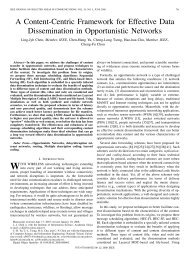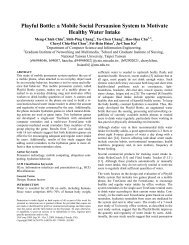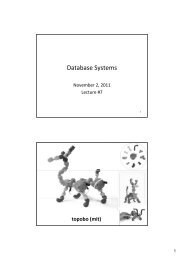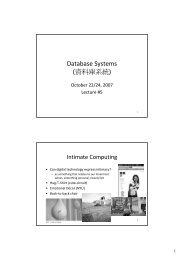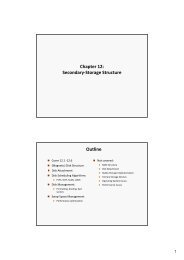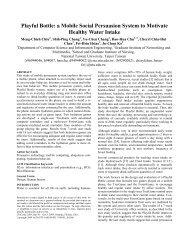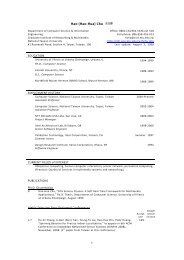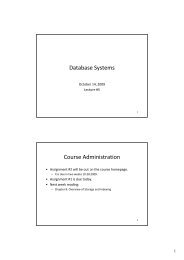Database Systems Assignment 4: Buffer Manager
Database Systems Assignment 4: Buffer Manager
Database Systems Assignment 4: Buffer Manager
Create successful ePaper yourself
Turn your PDF publications into a flip-book with our unique Google optimized e-Paper software.
<strong>Database</strong> <strong>Systems</strong><br />
<strong>Assignment</strong> 4: <strong>Buffer</strong> <strong>Manager</strong><br />
Deadline: 23:59, Nov. 30 (Wednesday), 2011<br />
Instructor: Hao-Hua Chu, Winston Hsu<br />
Fall Semester, 2011<br />
This is a group assignment, and at most 2 students per group are allowed.<br />
Cheating Policy: If you are caught cheating, your grade is 0.<br />
Late Policy: We will not accept any assignment submissions after Wednesday.<br />
Introduction<br />
In this assignment, you will have to implement a simple buffer management layer<br />
(without support for concurrency control and recovery) for the Minibase database<br />
system. The code for the underlying Disk Space <strong>Manager</strong> will be given. HTML<br />
documentation for Minibase is available on web<br />
(http://www.cs.wisc.edu/coral/minibase/project.html). In particular, you should<br />
read the description of the DB class, which you will use extensively in this<br />
assignment.<br />
Note: The Minibase buffer manager layer differs from what you have to implement<br />
in that it contains methods to support concurrency control and recovery.<br />
Design Overview and Implementation Details<br />
The buffer pool is collection of frames (page-sized sequence of main memory bytes)<br />
that is managed by the <strong>Buffer</strong> <strong>Manager</strong>. It should be stored as an array<br />
bufPool[numbuf] of Page objects. In addition, you should maintain an array<br />
bufDescr[numbuf] of descriptors, one per frame. Each descriptor is a record with<br />
the following fields:<br />
page number, mode, pin_count, dirtybit,<br />
The page number is a PageId object, the mode is read or read/write (MODE type),<br />
the pin_count field is an integer, and dirtybit is a boolean. This describes the page<br />
that is stored in the corresponding frame.
Page id<br />
A page is identified by a page number that is generated by the DB class when the<br />
page is allocated, and is unique over all pages in the database. The PageId type is<br />
defined as an integer type in minirel.h.<br />
h<br />
Directory<br />
A simple hash table should be used to figure out what frame the given page<br />
occupies. The hash table should be implemented (entirely in main memory) by<br />
using an array of pointers to lists of pairs. The array<br />
is called the directory and each list of pairs is called a bucket. Given a page number,<br />
you should apply a hash function to find the directory entry pointing to the bucket<br />
that contains the frame number for this page. If you search the bucket and don’t<br />
find a pair containing this page number, the page is not in the pool. If you find such<br />
a pair, it will tell you the frame which the page is in.<br />
The hash function must distribute values in the domain of the search field<br />
uniformly over the collection of buckets. If we have HTSIZE buckets, numbered 0<br />
through M-1, a hash function h of the form<br />
…<br />
…<br />
…<br />
…<br />
Page ID -> Frame ID Bucket<br />
…<br />
…<br />
…<br />
…<br />
data data data data data data …<br />
h(value) = (a * value + b)mod HTSIZE<br />
works well in practice. HTSIZE should be chosen to be a prime number.<br />
…<br />
<strong>Buffer</strong> pool
When a page is requested the buffer manager should do the following: Check the<br />
buffer pool (by using the hash table) to see if it contains the requested page. If the<br />
page is in the pool, you have to make sure that the page pinned as<br />
READ_WRITE_MODE cannot be pinned again (write exclusive condition). On the<br />
other hand, the page has been pinned before cannot be pinned again as<br />
READ_WRITE_MODE. In sum, the page can only be pinned multiple times in<br />
READ_MODE.<br />
If the page is not in the pool, it should be brought in as follows:<br />
Choose a frame for replacement, using the LOVE/HATE replacement<br />
policy.<br />
If the frame chosen for replacement is dirty, flush it (i.e., write out the<br />
page that is contains to disk, using the appropriate DB class method).<br />
Read the requested page (again, by calling the DB class) into the frame<br />
chosen for replacement; the pin_count and dirtybit for the frame should<br />
be initialized to 0 and FALSE, respectively.<br />
Delete the entry for the old page from the <strong>Buffer</strong> <strong>Manager</strong>’s hash table<br />
and insert an entry for the new page. Also, update the entry for this<br />
frame in the bufDescr array to reflect these changes.<br />
Pin the requested page by incrementing the pin_count in the descriptor<br />
for this frame and return a pointer to the page to the requester.<br />
Theoretically, the best candidate page for replacement is the page that will be last<br />
requested in the future. Since implementing such policy requires a future<br />
predicting oracle, all buffer replacement policies try to approximate it one way or<br />
another. The LRU (Least Recently Used) policy, for example, uses the past access<br />
pattern as an indication for the future. However, sequential flooding can ruin this<br />
scheme and MRU (Most Recently Used) becomes more appropriate in this<br />
particular situation.<br />
In this assignment you are supposed to implement the love/hate replacement
policy. The policy tries to enhance prediction of the future by relying on a hint from<br />
the upper levels about the page. The upper level user hints the buffer manager that<br />
the page is loved if it is more likely that the page will be needed in the future, and<br />
hated if it is more likely that the page will not be needed. The policy is supposed to<br />
maintain an MRU list for the hated pages and an LRU list for the loved pages. If a<br />
page is needed for replacement, the buffer manager selects from the list of hated<br />
pages first and then from the loved pages if no hated one exist. A situation may<br />
arise when a page is both loved and hated at the same time. This can happen if the<br />
page was pinned by two different users and then was unpinned by the first one as a<br />
hated page and by the other as a loved page. In this case, assume that “love<br />
conquers hate”, meaning that once a page is indicated as loved it should remain<br />
loved. Another thing you should be careful is which time should be used to handle<br />
love LRU and hate MRU list. When someone unpin a love page with hate, you<br />
should not update the time. And, when someone unpin with original mode, you<br />
should update the time.<br />
The <strong>Buffer</strong> <strong>Manager</strong> Interface<br />
The simplified buffer manager interface that you will implement allows a higher<br />
level program to allocate and deallocate pages on disk, to bring a disk page to the<br />
buffer pool and pin it, and to unpin a page in the buffer pool.<br />
The methods that you have to implement are described below:<br />
enum MODE {<br />
};<br />
READ_MODE, READ_WRITE_MODE;<br />
class BufMgr {<br />
public:<br />
page* bufPool;<br />
// The physical buffer pool of pages.<br />
public:<br />
BufMgr(int numbuf, Replacer *replacer = 0);<br />
// Initializes a buffer manager managing "numbuf" buffers.<br />
// Disregard the "replacer" parameter for now. In the full<br />
// implementation of minibase, it is a pointer to an object<br />
// representing one of several buffer pool replacement schemes.<br />
~BufMgr();<br />
// Should flush all dirty pages in the pool to disk before shutting down<br />
// and deallocate the buffer pool in main memory.<br />
Status pinPage(PageId PageId_in_a_DB, Page*& page, MODE mode);
};<br />
// Check if this page is in buffer pool. If it is, increment the pin_count<br />
// and let page be a pointer to this page. If the pin_count was 0 before the<br />
// call, the page was a replacement candidate, but is no longer a candidate.<br />
// If the page is not in the pool, choose a frame (from the set of replacement<br />
// candidates) to hold this page, read the page (using the appropriate DB<br />
// class method) and pin it. (If there is no candidate, return error.)<br />
// Also, you must write out the old page in chosen frame if it is dirty before<br />
// reading new page.<br />
// you must check on read/write mode, if the pinned page has been pinned<br />
before, make sure that write<br />
// exclusive condition is hold, else return error<br />
Status unpinPage(PageId globalPageId_in_a_DB, int diry, int hate);<br />
// hate should be TRUE if type page is “hated” and FALSE if the is loved.<br />
// User should call this with dirty = TRUE if the page has be modified.<br />
// If so, this call should set the dirty bit for this frame. Further, if pin_count > 0<br />
// should decrement it.<br />
// If pin_count = 0 before this call, return error.<br />
Status newPage(PageId& firstPageId, Page*& firstpage, int howmany=1);<br />
// Find a frame in the buffer pool for the first page.<br />
// If a frame exists, call DB object to allocate a run of new pages and pin it in<br />
read_write_ mode.<br />
// (This call allows a client of the <strong>Buffer</strong> <strong>Manager</strong> to allocate pages on disk.)<br />
// If buffer is full, i.e., you can’t find a frame for the first page, return error.<br />
Status freePage(PageId globalPageId);<br />
// This method should be called to delete a page that is on disk.<br />
// This routine must call the DB class to deallocate the page.<br />
// (When the page is be pinned you should return error.)<br />
Status flushPage(int pageId);<br />
// Used to flush a particular page of the buffer pool to disk<br />
// (without modify love/hate list)<br />
// Should call the write_page method of the DB class.<br />
Status flushAllPages();<br />
// Flush all pages of the buffer pool to disk.<br />
Compiling Your Code and Running the Tests<br />
Copy all the files from web site into your working directory. The files are:
Makefile: A sample makefile to compile your project. You will have to set up<br />
any dependencies by editing this file. You may also use your own makefile.<br />
buf.h: This file contains the specifications for the class BufMgr and you have to<br />
implement these specification as part of this assignment.<br />
main.C, test_driver.C, BMTester.C: <strong>Buffer</strong> manager test driver program.<br />
sample_output: Sample output of a correct implementation.<br />
ErrProc.sample: This file shows you how to use the error protocol in Minibase.<br />
If you make the project, it will create an executable named buftest. Right now, it<br />
does not work, even can’t be compiled correctly. You will need to modified buf.h to<br />
add your own structures of hash table, LRU and MRU lists. Furthermore, you<br />
should implement all these method bodies in file buf.C.<br />
How to hand-in<br />
Email the files “buf.h”, “buf.C” and a one-page document to<br />
cclee@cmlab.csie.ntu.edu.tw before the deadline with the title “[DB11] hw4_ID_ID”<br />
(Ex. “[DB11] hw4_b97902xxx” or “[DB11] hw4_b97902xxx_b97902xxx”).



